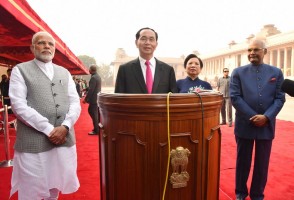
Rising oil prices big macro worry for Indian economy: Trade body
The Dollar Business Bureau  Increasing crude oil prices in the international market has led to an increased risk of volatility in energy prices. With Indian basket of crude oil rising by 11% in rupee terms in the last 8-9 days, volatility in energy prices has re-surfaced as the biggest worry for the Indian industry and policy makers, according to an The Associated Chambers of Commerce of India (ASSOCHAM) report. In rupee terms, prices for the Indian crude basket have shot up by 11% from Rs 3789.86 to Rs 4203.94 per barrel between May 1 and May 7. In dollar terms, the prices have gone up by more than 9% from US$ 60.30 l to US$ 65.81 per barrel. “The worry is being aggravated by the pressure on rupee as crude is looking up in the international market. While it is early days to press the panic button, caution and a contingent plan should be in order if the situation gets worsened by monsoon deficiency, going forward,” the study said. Upward revision in the pump prices every fortnight by the oil companies - if rupee further weakens and bullish sentiment returns to the energy- would not make good headlines for the economic sentiment, it said. “While it was a great news for India when the crude prices came down significantly from US$ 105 per barrel all the way down to US$ 45 per barrel, now is time for caution and care for all the stakeholders- consumers, industry, government and the Reserve Bank of India,” said D S Rawat said, Secretary General, ASSOCHAM. Like governments and central banks, the industry hates uncertainties and volatility. But then the hard fact is one has to keep ready for any volatility, especially learning from the way it fell. “If prices could fall so sharply in a matter of few months, the reverse could also happen. The big question now being asked is will it now rise further?” Some analysts say that while the prices were falling, the biggest oil producer Saudi Arabia had a game plan in the price war. It had an eye on the capex spending in the global oil economy and the supply situation in the US. The supply situation in the US is turning weak, setting the stage for the oil price war to end, reports suggest. “That is not a good news for India, which is on the cusp of recovery, but the macro factors are suddenly turning weak, poor outlook of monsoon including.” One of the reasons for Saudi Arabia to increase the production is a belief that it is only through some aggressive pricing of keeping the crude oil prices below US$ 50 per barrel that the competition from shale gas in the US can be checkmated. However, slowdown in the Chinese economy can still be a good news for the oil prices since subdued growth in China can dampen the crude demand, thus affecting its prices. Meltdown in energy prices had a resounding effect on inflation in general in the last one year. The global annual inflation for energy was down by 50.2% in January. It could be having some nexus , either cause or effect, or part of the overall commodity cycle, but the annual global inflation for a variety of other items such as raw materials, metals and minerals went down by 12.2 % and 16.2% respectively in January, 2015 over the same month last year.
Increasing crude oil prices in the international market has led to an increased risk of volatility in energy prices. With Indian basket of crude oil rising by 11% in rupee terms in the last 8-9 days, volatility in energy prices has re-surfaced as the biggest worry for the Indian industry and policy makers, according to an The Associated Chambers of Commerce of India (ASSOCHAM) report. In rupee terms, prices for the Indian crude basket have shot up by 11% from Rs 3789.86 to Rs 4203.94 per barrel between May 1 and May 7. In dollar terms, the prices have gone up by more than 9% from US$ 60.30 l to US$ 65.81 per barrel. “The worry is being aggravated by the pressure on rupee as crude is looking up in the international market. While it is early days to press the panic button, caution and a contingent plan should be in order if the situation gets worsened by monsoon deficiency, going forward,” the study said. Upward revision in the pump prices every fortnight by the oil companies - if rupee further weakens and bullish sentiment returns to the energy- would not make good headlines for the economic sentiment, it said. “While it was a great news for India when the crude prices came down significantly from US$ 105 per barrel all the way down to US$ 45 per barrel, now is time for caution and care for all the stakeholders- consumers, industry, government and the Reserve Bank of India,” said D S Rawat said, Secretary General, ASSOCHAM. Like governments and central banks, the industry hates uncertainties and volatility. But then the hard fact is one has to keep ready for any volatility, especially learning from the way it fell. “If prices could fall so sharply in a matter of few months, the reverse could also happen. The big question now being asked is will it now rise further?” Some analysts say that while the prices were falling, the biggest oil producer Saudi Arabia had a game plan in the price war. It had an eye on the capex spending in the global oil economy and the supply situation in the US. The supply situation in the US is turning weak, setting the stage for the oil price war to end, reports suggest. “That is not a good news for India, which is on the cusp of recovery, but the macro factors are suddenly turning weak, poor outlook of monsoon including.” One of the reasons for Saudi Arabia to increase the production is a belief that it is only through some aggressive pricing of keeping the crude oil prices below US$ 50 per barrel that the competition from shale gas in the US can be checkmated. However, slowdown in the Chinese economy can still be a good news for the oil prices since subdued growth in China can dampen the crude demand, thus affecting its prices. Meltdown in energy prices had a resounding effect on inflation in general in the last one year. The global annual inflation for energy was down by 50.2% in January. It could be having some nexus , either cause or effect, or part of the overall commodity cycle, but the annual global inflation for a variety of other items such as raw materials, metals and minerals went down by 12.2 % and 16.2% respectively in January, 2015 over the same month last year.
May 11, 2015 | 5:06 pm IST.






 to success.
to success.